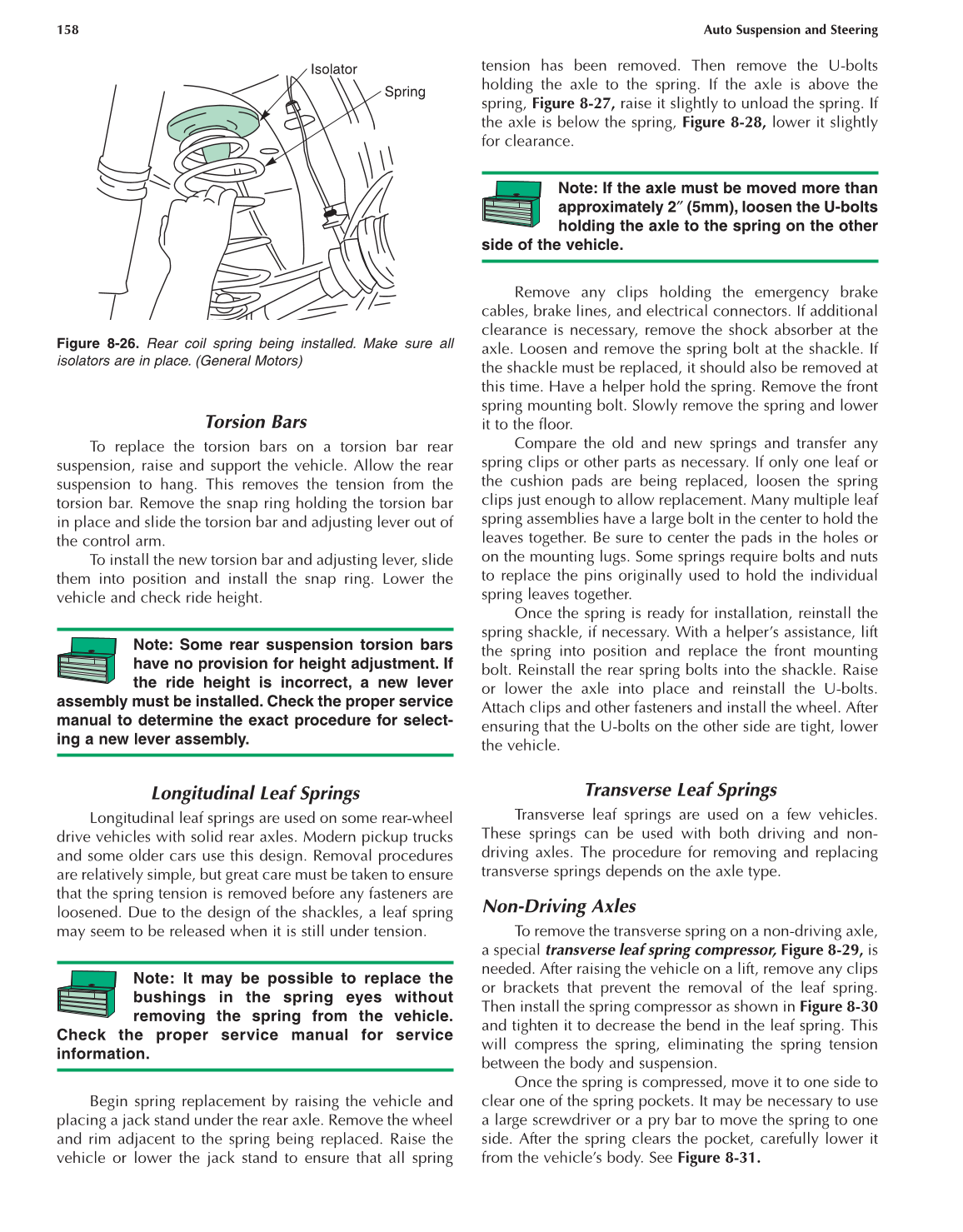158 Auto Suspension and Steering
Torsion Bars
To replace the torsion bars on a torsion bar rear
suspension, raise and support the vehicle. Allow the rear
suspension to hang. This removes the tension from the
torsion bar. Remove the snap ring holding the torsion bar
in place and slide the torsion bar and adjusting lever out of
the control arm.
To install the new torsion bar and adjusting lever, slide
them into position and install the snap ring. Lower the
vehicle and check ride height.
Note: Some rear suspension torsion bars
have no provision for height adjustment. If
the ride height is incorrect, a new lever
assembly must be installed. Check the proper service
manual to determine the exact procedure for select-
ing a new lever assembly.
Longitudinal Leaf Springs
Longitudinal leaf springs are used on some rear-wheel
drive vehicles with solid rear axles. Modern pickup trucks
and some older cars use this design. Removal procedures
are relatively simple, but great care must be taken to ensure
that the spring tension is removed before any fasteners are
loosened. Due to the design of the shackles, a leaf spring
may seem to be released when it is still under tension.
Note: It may be possible to replace the
bushings in the spring eyes without
removing the spring from the vehicle.
Check the proper service manual for service
information.
Begin spring replacement by raising the vehicle and
placing a jack stand under the rear axle. Remove the wheel
and rim adjacent to the spring being replaced. Raise the
vehicle or lower the jack stand to ensure that all spring
tension has been removed. Then remove the U-bolts
holding the axle to the spring. If the axle is above the
spring, Figure 8-27, raise it slightly to unload the spring. If
the axle is below the spring, Figure 8-28, lower it slightly
for clearance.
Note: If the axle must be moved more than
approximately 2″ (5mm), loosen the U-bolts
holding the axle to the spring on the other
side of the vehicle.
Remove any clips holding the emergency brake
cables, brake lines, and electrical connectors. If additional
clearance is necessary, remove the shock absorber at the
axle. Loosen and remove the spring bolt at the shackle. If
the shackle must be replaced, it should also be removed at
this time. Have a helper hold the spring. Remove the front
spring mounting bolt. Slowly remove the spring and lower
it to the floor.
Compare the old and new springs and transfer any
spring clips or other parts as necessary. If only one leaf or
the cushion pads are being replaced, loosen the spring
clips just enough to allow replacement. Many multiple leaf
spring assemblies have a large bolt in the center to hold the
leaves together. Be sure to center the pads in the holes or
on the mounting lugs. Some springs require bolts and nuts
to replace the pins originally used to hold the individual
spring leaves together.
Once the spring is ready for installation, reinstall the
spring shackle, if necessary. With a helper’s assistance, lift
the spring into position and replace the front mounting
bolt. Reinstall the rear spring bolts into the shackle. Raise
or lower the axle into place and reinstall the U-bolts.
Attach clips and other fasteners and install the wheel. After
ensuring that the U-bolts on the other side are tight, lower
the vehicle.
Transverse Leaf Springs
Transverse leaf springs are used on a few vehicles.
These springs can be used with both driving and non-
driving axles. The procedure for removing and replacing
transverse springs depends on the axle type.
Non-Driving Axles
To remove the transverse spring on a non-driving axle,
a special transverse leaf spring compressor, Figure 8-29, is
needed. After raising the vehicle on a lift, remove any clips
or brackets that prevent the removal of the leaf spring.
Then install the spring compressor as shown in Figure 8-30
and tighten it to decrease the bend in the leaf spring. This
will compress the spring, eliminating the spring tension
between the body and suspension.
Once the spring is compressed, move it to one side to
clear one of the spring pockets. It may be necessary to use
a large screwdriver or a pry bar to move the spring to one
side. After the spring clears the pocket, carefully lower it
from the vehicle’s body. See Figure 8-31.
Isolator
Spring
Figure 8-26. Rear coil spring being installed. Make sure all
isolators are in place. (General Motors)
